STEVE MEYERS:
My name is Steve Meyers.
And I want to thank you for taking part in this exclusive Money Morning interview with Jim Rickards, the Financial Threat and Asymmetric Warfare Advisor for both the Pentagon and CIA.
Recently, all 16 branches of our Intelligence Community have come together to release a shocking report.
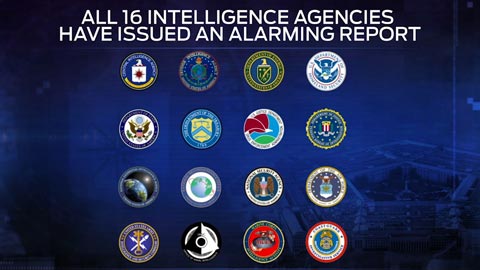
These agencies, that include the CIA, FBI, Army, and Navy, they’ve already begun to estimate the impact of the fall of the dollar as the global reserve currency.
And our reign as the world’s leading super power being annihilated in a way equivalent to the end of the British Empire, post-World War II.
And the end game could be a nightmarish scenario, where the world falls into an extended period of global anarchy.
Jim Rickards fears he and his colleagues’ warnings are being ignored by our political leaders and the Federal Reserve, and we’re on the verge of entering the darkest economic period in our nation’s history.
One that will ignite a 25-year Great Depression.
Today, we’re going to examine everything he’s uncovered because the bedlam could begin within the next six months.
Which is why every American should hear his warnings before it’s too late.
Jim Rickards, thank you for joining us.
(continue reading transcript in entirety beyond page-break)
JIM RICKARDS:
It’s my pleasure, Steve. Glad to be with you.
STEVE MEYERS:
In the early ’80s, you were a member of the team that helped negotiate an end to the Iran hostage crisis.
In the late ’90s, when it was discovered that the Wall Street firm Long-Term Capital Management was about to cause a total collapse of the financial markets, the Federal Reserve had to turn to you in order to stop this catastrophe from plunging America into a recession.
And then, after 9/11, you were tasked by the CIA with investigating potential insider trading that took place prior to the terrorist attacks.
JIM RICKARDS:
That’s exactly right.
The problem was the CIA didn’t have any capital markets expertise.
And why should they?
Prior to the beginning of globalization, capital markets weren’t really part of the battle space.
So the CIA engaged in some outreach, they recruited certain people, myself included, to bring the Wall Street expertise to the agency.
This Led to Project Prophecy
So, what the CIA said was, well, if there’s going to be another spectacular attack…
Using price signals to determine the actions of participants in the market, whether it be terrorists, or strategic rivals of the United States…
Could you spot it?
Could you get the information, and actually break up the plot, and save American lives?
STEVE MEYERS:
This system you built with Project Prophecy actually predicted a terrorist attack that was thwarted in 2006.
JIM RICKARDS:
On August 7, 2006, I got an email from my partner.
She said, “Jim, we’ve got a bright signal on American Airlines.
It looks like a possible terrorist attack.”
We documented that.
I was up at 2:00 in the morning in my study, watching CNN, and all of a sudden MI-5 and New Scotland Yard emerged to break up this terrorist attack.
They were arresting suspects and removing files.
So this showed that the system worked.
However, it’s not just good for predicting terrorist attacks, but also strategic attacks by rivals and enemies of the United States.
STEVE MEYERS:
For years now, you’ve been helping the Pentagon and CIA prepare for a rise in asymmetric warfare and financial threats, because today there are immense fears we’ll be struck by – as you’ve described it before – a financial Pearl Harbor.
JIM RICKARDS:
There’s now concern in different branches of the U.S. government…
Historically in Washington, the Treasury and the Fed take care of the dollar.
The Pentagon and the Intelligence Community take care of other threats, but what happens when the dollar IS the threat?

Americans generally know that:
- The Fed has increased the money supply by $3.1 trillion.
- We have $17.5 trillion of debt.
- We have $127 trillion of unfunded liabilities.
What are those?
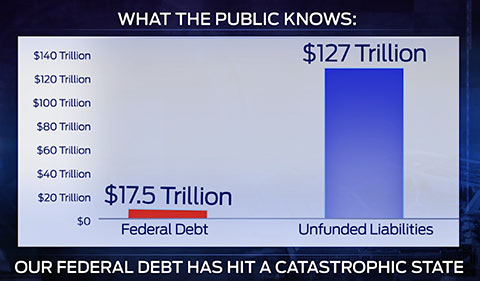
Medicare, Medicaid, Social Security, student loans, Fannie Mae, Freddie Mac, FHA.
You go through the whole list and it goes on and on and on.
There’s no way to pay it.
Debt can no longer be used to artificially grow our economy.
During the boom years of the 1950s and 1960s, every dollar of debt that was created, we got $2.41 worth of economic growth.
So that was pretty good bang for the buck.
But by the “stagflation” of the late 1970s that relationship had actually collapsed.
So now for a dollar of debt in the late 1970s, we were only getting $.41 in growth, so, obviously, that’s a huge drop-off.
You know what that number is today? Today, we only get $.03 in growth for every $1 of debt.
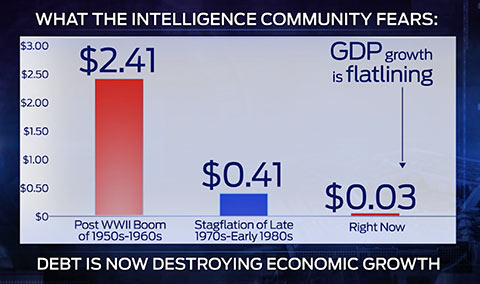
So we’re piling on the debt, but we’re getting less and less growth.
As the trend goes from $2.41 to $.41 to $.03…
It’s soon going to go negative.
This is a signal of a complex system about to collapse.
STEVE MEYERS:
This really speaks to what you wrote about in your new book, The Death of Money, the title strongly alludes to this, the hourglass is now empty.
You warn we’re about to fall into a 25-year Great Depression…
That the stock market could plunge overnight 70%.
JIM RICKARDS:
(Interrupts)
You know, when I use the phrase 25-year depression, it sounds a little extreme, but historically it’s not.
We had a 30-year depression in the United States from about 1870 to 1900. Economists actually call it the Long Depression.
That was before the Great Depression. The Great Depression lasted from 1929 to 1940, so that was quite long.
The U.S. is in a Depression Today
STEVE MEYERS:
A lot of folks might disagree with you that we’re currently in a depression.
That word brings to mind images of the 1930s and soup kitchens.
JIM RICKARDS:
Well, we have soup kitchens today…
They’re just at Whole Foods and your local supermarket, because 50 million Americans are on food stamps.
It’s not that we don’t have distress.
We have enormous distress, but it’s being hidden in different ways.
The unemployment rate today is actually 23% when you calculate it the right way.
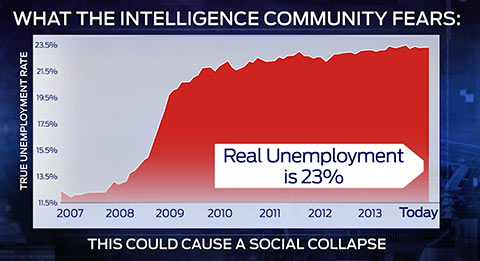
STEVE MEYERS:
And you point the finger right at the Fed, Congress, and the White House.
JIM RICKARDS:
(Interrupts)
I was in a meeting in the Treasury and I said:
“The Fed and the Treasury are the greatest threats to national security, not Al- Qaeda.”
Right here in this building with this group…
You people are destroying the dollar and it’s just a matter of time before it collapses.
And I testified before the United States Senate about this.

I warned the Senate, maybe we can’t stop earthquakes on the San Andreas Fault…
But nobody thinks it’s a good idea to send the Army Corps of Engineers out there to make the San Andreas Fault bigger.
But by money printing, credit creation, and reckless monetary policy by the Fed, we’re making the San Andreas Fault bigger every day.
And when you make a complex system bigger – the risk doesn’t go up a little bit – it goes up exponentially. So the risk is unimaginable at this time.
The collapse hasn’t happened yet, but the forces are building up and it’s just about to snap.
Editor’s Note: Because the revelations in Jim Rickard’s book are so important to the everyday lives of Americans, Money Morning is sending free copies of The Death of Money to people who want to get this intelligence in their hands.
STEVE MEYERS:
Jim, your take, and that of many in the Intelligence Community…
Is much different than what we’re hearing out of Capitol Hill.
Which is why the allegations you make in this book are causing quite a controversy in Washington.
JIM RICKARDS:
I was at a recent conclave in the Rocky Mountains with a couple central bankers, one from the Federal Reserve and one from the Bank of England.
They’ll say things privately that they won’t say publicly.
And I was handed a copy of Janet Yellen’s playbook.
The Fed is trying to kind of use propaganda…
Lie to us about economic prospects, talk about green shoots, use happy talk to try to get us to spend our money.
The Fed doesn’t know what they’re doing.
Don’t ever think that they know what they’re doing.
You can print all the money you want, but if people are not borrowing it, if they’re not spending it, then your economy is collapsing, even with money printing.
So you can understand it this way…
Let’s say I go out to dinner and I tip the waiter.
And the waiter takes my tip and he takes a taxicab home.
And the taxi driver takes the fare and puts some gas in her taxicab.
Well, in that example, my dollar had the velocity of three.
$1 supported $3 of goods and services: the tip, the taxi ride, and the gasoline.
But, what if I don’t feel great? I stay home, and watch television.
I don’t spend any money.
Well, that money now has a velocity of zero.
I leave my money in the bank, but I don’t spend it.
Let’s look at what’s actually happening with the velocity of money.
It’s plunging… It’s going down very rapidly.
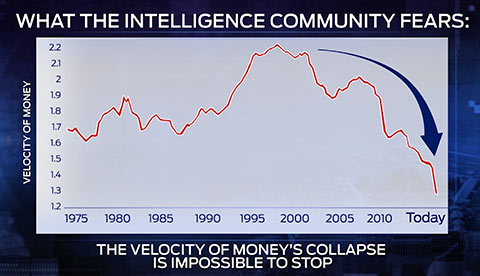
But compare this decline of velocity today to what we saw leading up the Great Depression.
Now, in the depths of the Great Depression velocity was even lower…
But…
If you compare what’s going on today to what happened in the late 1920s just prior to the Great Depression, there’s a very striking resemblance.
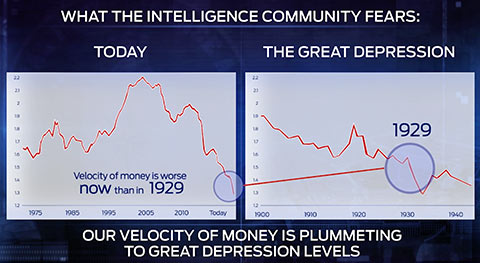
So, it doesn’t matter how much money the Fed prints.
Think of it as an airplane that’s coming in for a nosedive.
It’s crashing… crashing… getting closer to the ground.
The Fed is trying to grab the joystick and pull the plane up out of the nosedive and get it back in the air…
But, unfortunately, it’s not working, we’re heading for a crash.
STEVE MEYERS:
We’ve just covered a lot of these startling numbers, these signals of this coming Great Depression.
Let me see if I can quickly put it all together.
Nobody denies that we have a debt crisis in this country, but you’re saying we can no longer grow our debt without causing our economy to aggressively slow down.
We’re barely above water now.
So that’s signal number one.
Signal number two is this dangerous slowdown in our velocity of money.
It’s already plummeting to levels not witnessed since the Great Depression in the 1930s.
Are there any other signals the Intelligence Community is monitoring that suggest this collapse is right around the corner?
Editor’s Note: Jim Rickards reveals the early warning signs the U.S. Intelligence Community is tracking in advance of this coming 25-year Great Depression in his book,The Death of Money.
Money Morning believes this is a must-read for every American. So you can have a copy rushed to you for free.
JIM RICKARDS:
There are, Steve.
There are a lot of signals out there and they’re very, very troubling.
One of the ones I’m watching closely, and I know people in the Intelligence Community focus on also, because it covers so much ground, is called the Misery Index.
The Misery Index = Real Inflation Rate + Real Unemployment Rate
If you look at the Misery Index today compared to the period of stagflation in the late 1970s and early ’80s that Americans remember so well…
It’s actually worse.
This can lead to social instability…
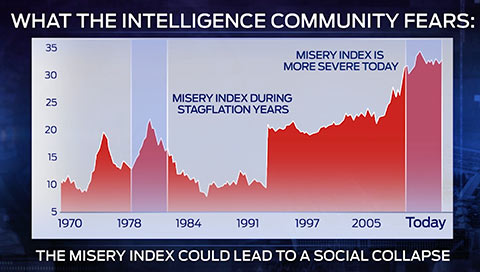
Take this back to the Great Depression… The Misery Index in the Great Depression was 27.
Today it’s 32.89.
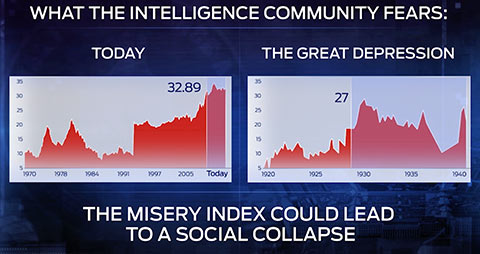
Believe it or not, it’s worse today than it was during the Great Depression.
What happens as a depression worsens?
Businesses can’t pay their debts. The bad losses fall on the banks. The banks ultimately fail.
That’s happened before.
The Fed has had to bail out the banks.
But what happens when the Fed, itself, is in jeopardy?
STEVE MEYERS:
Based on these signals you’ve been tracking, the Federal Reserve is going to fail?
JIM RICKARDS:
The Federal Reserve actually, in some ways, already has failed.
I spoke to a member of the Board of Governors of the Federal Reserve and I said, “I think the Fed is insolvent.”
This Governor first resisted and said, “No, we’re not.”
But, I pressed her a little bit harder and she said, “Well, maybe.”
And, then, I just looked at her and she said, “Well, we are, but it doesn’t matter.”
In other words, here’s a Governor of the Federal Reserve admitting to me, privately, that the Federal Reserve is insolvent, but said, it doesn’t matter, because central banks don’t need capital.
Well, I’m going to suggest that central banks do need capital.
Look at this chart.
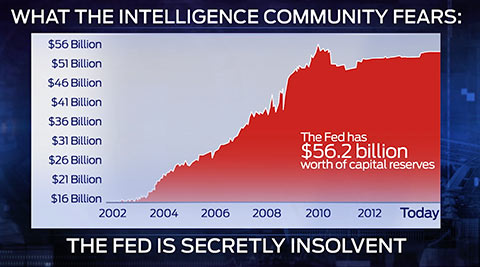
What it shows you is that the Fed has increased its capital they currently have about $56 billion.
That sounds good.
You say, “gee, $56 billion is a lot of money, that’s a pretty good capital base.”
But That’s Not the Whole Story
You have to compare the capital to the balance sheet.
How much in the way of assets and liabilities is that amount of capital supporting.
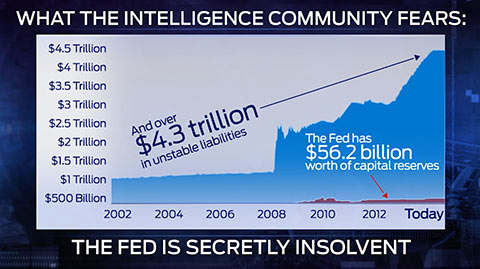
When you look at that it’s a much scarier picture, because the actual liabilities, or debt, if you will, on the Fed’s books is $4.3 trillion.
So you’ve got $4.3 trillion sitting on this little skinny capital base of $56 billion…
That’s very unstable.
Prior to 2008, the Fed’s leverage was about 22 to 1.
Meaning they had $22 in debt on their books for every $1 of capital.
Today, that leverage is 77 to 1.
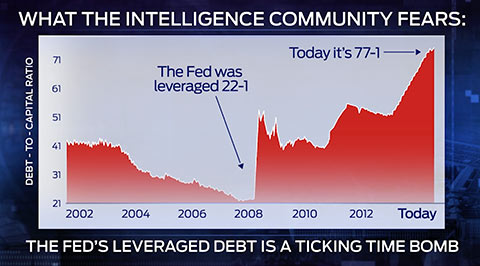
So, yes, the capital has increased, but the debt and the liability has increased much more.
STEVE MEYERS:
Your warnings haven’t gone completely ignored.
In the budget he presented this year, Senator Rand Paul cited your work and how we’ve driven our economy to the edge of a Roman Empire-like collapse.
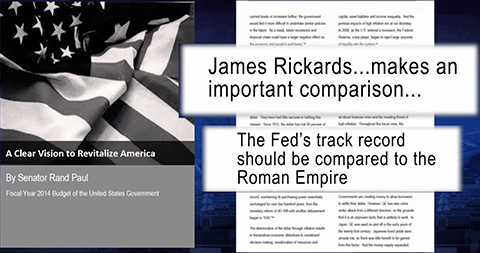
In fact, we have footage of Senator Paul instructing Americans to listen to your warnings.
SENATOR RAND PAUL:
Jim Rickards notes the Fed is insolvent on a mark-to-market basis.
The Fed has wiped out its capital on a mark-to-market basis.
Of course, the Fed carries these notes on its balance sheet at cost and does not mark them down to market.
But if they did, they would be broke.
JIM RICKARDS:
First of all, I give Senator Rand Paul credit.
He’s one of the few people who understand the dangers here.
But, the problem is not limited to the Fed.
It’s infecting the private banking system as well.
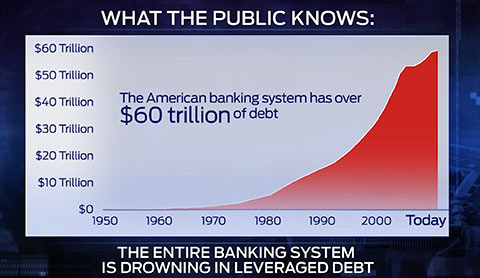
There’s about $60 trillion of debt on the balance sheets of our banking system.
For a long time, debt and the banks grew at about two times the rate of growth in the economy.
But lately, this has exploded.
Today it’s up to 30 to 1.

In other words, for every dollar of economic growth, there’s $30 of credit being created by the banking system.
The Whole Thing is Unstable
I can give you a very good example of this and this actually comes from physics.
If you had, let’s say, a 35-pound block of uranium shaped like a cube, it would actually be fairly harmless.
It’s what we call sub-critical. It’s radioactive, but it’s kind of tame.
But now imagine you engineer it.
You take that 35-pound block.
You take one piece and shape it into something about the size of a grapefruit.
Take another piece, shape it into something like a bat.
Put the ball and the bat in a tube and fire them together with high explosives.
That sets off a nuclear detonation.
That destroys a city.
The way it’s been shaped and configured is what takes it from what we call sub-critical to super-critical.
STEVE MEYERS:
Jim, are you seeing any signs that our stock market has reached a super-critical state?
JIM RICKARDS:
Well, unfortunately, yes.
We’re seeing a lot of signs of this.
One of the signs that’s really fundamental, and really important, is the ratio of stock market capitalization to GDP.
Because, remember, the value of all the stocks in the stock market, that’s supposed to represent the fundamental economy.
It’s not supposed to be off in a world of its own.
But if you look at what’s been happening to that ratio recently, it’s going sky-high.
It’s 203%.
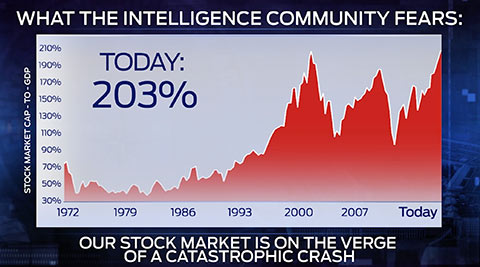
Just prior to the recession…
That number was 183%.
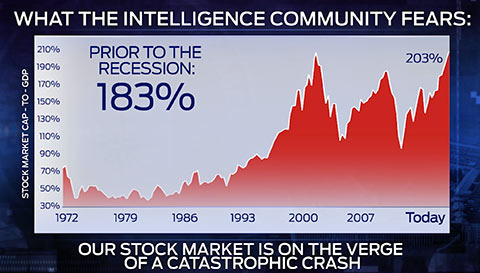
Go back to the famous tech bubble, the dot com implosion of 2000.
At that time, it was 204%.
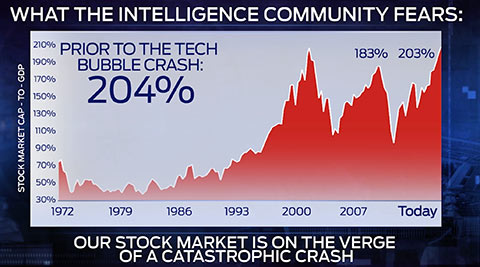
And if you want the scariest news of all…
Just prior to the Great Depression that number was 87%.

In other words…
The stock market capitalization, as a percentage of GDP, is twice as high as it was just prior to the Great Depression.
So, that’s a really good metric for saying, “Hey, is the stock market heading for a crash?”
All the data says, “Yes, we are.”
But there’s another metric, another warning sign, if you will, that’s even more frightening, which is the Gross Notional Value of Derivatives.
There are a certain number of shares of IBM that are outstanding, but we know what that number is.
But there’s no limit on the derivatives.
I can write options and futures on IBM stock all day long and all the other stocks on the stock market.
And that’s what’s been going on.
Now, the Gross Notional Value of Derivatives in the world today is over $700 trillion. Not billion.
$700 trillion.
That’s ten times the global GDP.
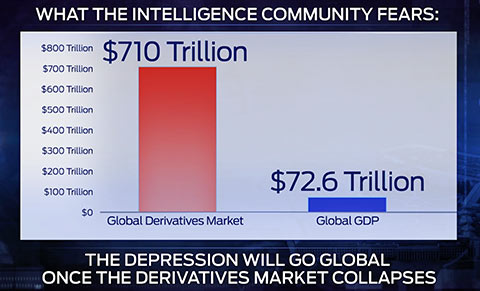
This collapse is unavoidable.
So, we ask ourselves, how bad can this be?
Well, what happened in 2007, 2008 when the markets collapsed…
We all remember the value of stocks going down…
Real estate going down, housing going down…
All that lost wealth was $60 trillion.
The problem is now the system is bigger, so I would expect the lost wealth this time to be $100 Trillion – possibly a lot more.
We’re in this critical state, getting close to the super-critical state where the system implodes.
But it takes a catalyst, it takes a flashpoint.
There are a number of potential flashpoints I’ve investigated.
Editor’s Note: Jim Rickards’ book, The Death of Money, provides specific guidance that can protect your wealth from this coming collapse.
STEVE MEYERS:
Jim, in a few moments I want to discuss the steps Americans need to take with their investments and personal finances to prepare for everything you and your colleagues are predicting.
But now let’s quickly focus on some of these major flashpoints.
JIM RICKARDS:
One of the key flashpoints we’re looking at is foreign ownership of U.S. government debt.
Now, this is a very important thing to understand.
We all know that the Treasury has issued over $17 trillion worth of debt, the question is who buys it?
A lot of U.S. debt is owned by foreigners. Who owns it?
China, Russia, other countries…
Countries that are not necessarily our friends.
But they can dump it when they want to.
Well, guess what, that’s actually what’s been going on.
Recently, foreign holdings of U.S. government debt have been plummeting.
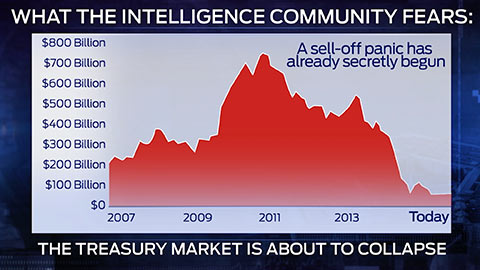
But it gets even more interesting than that.
We talked earlier about the project I did for the CIA…
Project Prophecy.
And we said, you can see not only market action, but rivals, enemies, terrorists and others, operating in financial markets.
So, we all know that Russia invaded Crimea in the spring of 2014.
Let’s say you’re Putin. You know you’re going to invade Crimea. You can expect U.S. financial sanctions.
So what do you do?
You basically mitigate the impact of the sanctions, start dumping treasuries in advance so that when you make your move and the Treasury tries to come against you, you’ve insulated yourself.
So go back and look at October 2013, here’s Russia dumping Treasuries month after month.
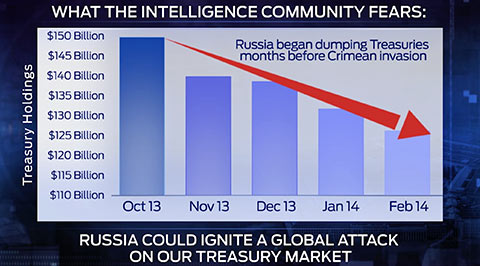
That was a clear signal that they were getting ready to do something…
To engage in financial warfare against the United States.
But guess what? It’s worse than that.
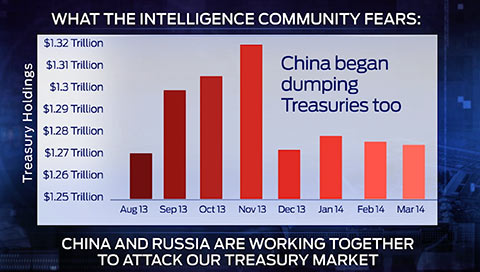
We know the Russians and Chinese are working together.
So is it any surprise that when the Russians started dumping…
The Chinese started dumping also?
STEVE MEYERS:
Does the Intelligence Community have the ability to defend our country in the event that this escalates even further?
JIM RICKARDS:
Believe it or not, there’s an intelligence unit inside the Treasury.
And they actually have a war room.
That tells you that financial warfare is here and it’s real.
So if the Russians are dumping…
The Chinese are dumping…
Who is going to buy all this debt?
Well, a mystery buyer has shown up.

Recently, Belgium has bought enormous amounts…
In the hundreds of billions of dollars of U.S. government securities.
STEVE MEYERS:
So Belgium started loading up on treasuries, coincidentally at the exact same time Russia and China began dumping theirs?
JIM RICKARDS:
(Interrupts)
It’s not the Belgians.
These amounts are bigger than the Belgian current account surplus.
These are not Belgian dentists who are buying these things.
Belgium is a Front
You know, could it be the Fed itself?
That’s the point.
Maybe the public doesn’t know who the mystery buyer is, but the national security community does.
Now, the Treasury, operating through this war room, and the Fed – the mystery buyer in Belgium…
For now, they have managed to prop up the treasury market.
It hasn’t collapsed yet.
But they’re not going to be able to keep pulling these rabbits out of a hat, there’s a limit.
This should be very scary, because if the Fed is tapped out – we talked earlier about how the Fed is leveraged 77 to 1.
So the Fed is at the limit of what they can do.
The foreigners are now dumping treasuries and if no one buys it, guess what, interest rates go up.
That’ll sink the stock market, that’ll sink the housing market.
Higher interest rates mean the debt gets higher, so interest rates go up some more.
So you start a death spiral and there’s no way out of it.
STEVE MEYERS:
An attack on our treasury market is obviously a very serious flashpoint that could ignite this Great Depression you predict in your book.
Let’s talk about another flashpoint.
JIM RICKARDS:
What I call flashpoint number two has to do with the petrodollar.
STEVE MEYERS:
Can you explain what you mean by the petrodollar?
JIM RICKARDS:
It’s basically a system whereby oil exports are priced in dollars.
Oil doesn’t have to be priced in dollars.
It could be priced in euros, Japanese yen, Swiss francs, gold.
It could be priced in a lot of things.
But, in fact, the whole global oil market is priced in dollars.
I was actually very close to the birth of the petrodollar system.
My first visit to the White House on official business was in 1974, with a small group, about five of us.
We met with Helmut Sonnenfeldt, who was the Deputy National Security Advisor at the time.
He was the number two to Henry Kissinger.
And, this was at a time you have to remember…
At the beginning of the ’70s oil was $2 a barrel.
At the end of the ’70s, oil was $12 a barrel.
This Was an Oil Shock
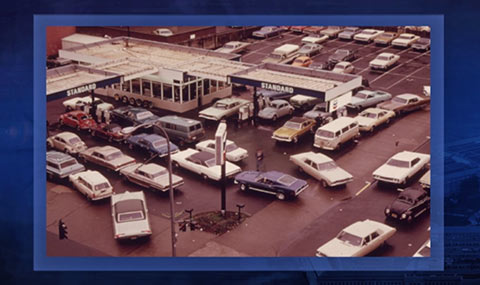
The price of oil was skyrocketing.
Inflation was getting out of control.
There were gas lines.
You know, a certain generation of Americans remembers this very well.
We were in the White House talking about what to do about this.
One of the scenarios we discussed was the U.S. military would invade Saudi Arabia.
We would secure the oil fields and create a military perimeter around them.
We would pump the oil and set it at a price that was favorable to us.
Now, we would give the money to the Saudis.
We didn’t want to steal their money.
We didn’t want to steal their oil.
We just wanted to set the price.
Now, fortunately, that plan was not carried out.
But it shows you how desperate things were at the time.
But what did happen?
Why did we not invade Saudi Arabia?
Well, the answer is Kissinger and the Saudis worked out a deal.
And the Saudis said, “Okay, we’ll price oil in dollars, so that secures the role of the dollar as the global reserve currency.”
But there was a quid pro quo.
We agreed to guarantee the continuation of the House of Saud, the royal family of Saudi Arabia.
And by extension, the national security of Saudi Arabia.
Because they’re a relatively weak military power.
And it’s a bad neighborhood – a lot of enemies in the region starting with Iran and others.
So the question would be, obviously, did this petrodollar deal work?
And it ABSOLUTELY did work.
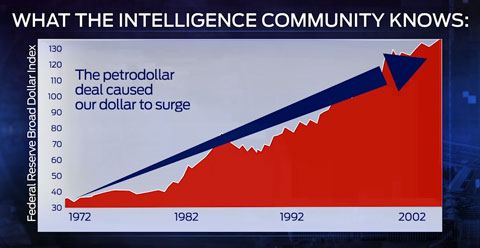
Once it kicked in, the dollar roared.
This was the period – sometimes people call it the king dollar period, the strong dollar period.
This was after Volcker and Reagan in the 1980s.
But this only continued up to a certain period of time…
Up until around 2000.
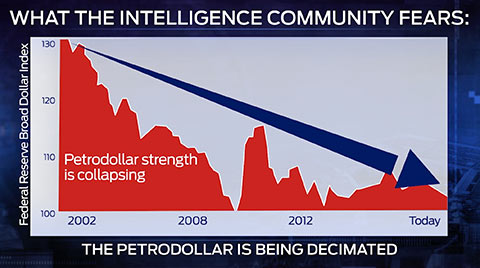
And since then, the dollar has been in a decline.
STEVE MEYERS:
So what could cause the fall of the petrodollar?
JIM RICKARDS:
Well, we’re seeing it in real time.
Think of the petrodollar, or the dollar as the global reserve currency…
Think of it as a three-legged stool.
So, here’s the stool and it’s got three legs.
As long as the legs are standing, the foundation is firm and the dollar will remain as a global reserve currency.
But, one by one, those legs are being pulled out.
What are the legs?
Well, the first one is Saudi Arabia.
That was where the petrodollar deal began.
Our side of the deal was we would guarantee the national security of Saudi Arabia.
But lately – going back to December of 2013…
President Obama stabbed the Saudis in the back by anointing Iran as the regional-hegemonic power.
You know, the President has been withdrawing American power from around the world and his view is, well, we’ll leave a friendly cop on the beat.
Every sort of bad neighborhood around the world will have a cop on the beat.
The President has decided that Iran is going to be the cop on the beat in the Middle East.
They’re going to be the heavyweight regional power.
Where does that leave Saudi Arabia? Out in the cold.
So now Saudi Arabia is saying…
“Wait a second, you’ve undermined our national security, you’ve reneged on your side of the petrodollar deal, why should we hold up our end?
Maybe we’ll start pricing oil in gold or euros or maybe Chinese yuan.”
Because now, increasingly, Saudi Arabia is selling more and more oil to China.
So, the first leg of the stool has been pulled out.
The Saudis are going to back away from the petrodollar, because we are no longer guaranteeing their security – we’re playing footsie with Iran.
The second leg of the stool is Russia.
Now, Russia is not a member of OPEC, but they are the world’s largest oil exporter, one of the world’s largest energy exporters, actually bigger than Saudi Arabia.
So even though they’re not a member of OPEC, they also price oil in dollars.
So, they’ve signed onto the petrodollar deal in their own way.
But, we’re now engaged in financial warfare, Russia is ready to fight back.
And this is not classified information.
This is being said publicly.
Andrei Kostin, President and Chairman of Russia’s VTB Bank, it’s one of the largest banks in Russia, he recently said…
“It’s time to change the entire international financial system that considers the dollar the key reserve currency. The world has changed.”
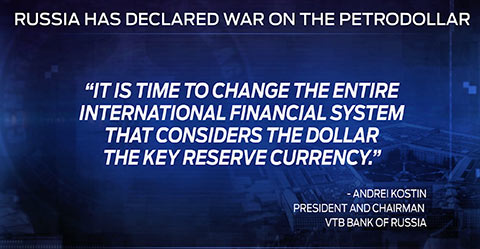
A member of the Russian Parliament, he said…
“The dollar is evil.
We will sell rubles to consumers that rely on gas and later we’ll exchange the rubles for gold.
If they don’t like this, let them not do it.
Let them freeze to death.”
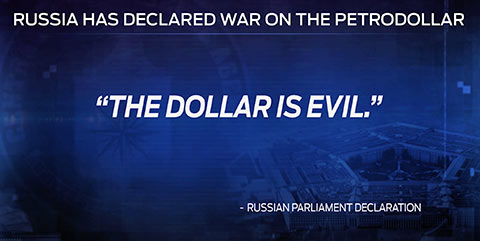
So, two of the legs of the stool, Saudi Arabia and Russia, have already been pulled out.
The third leg is China.
And that is coming out too.
STEVE MEYERS:
As far as Russia and China’s role in taking down the petrodollar…
This recent $400 billion energy alliance they signed, is that the purpose of it?
JIM RICKARDS:
Sure.
Russia is the world’s largest energy exporter, China is the fastest growing economy in the world, they need energy.
So this is a natural partnership between the two. But the dollar is out in the cold.
And, China is actually putting these yuan bilateral trade agreements in place all over the world.
They’re doing them one-by-one.
But once there’s enough trade and enough volume in a certain currency, it can become a reserve currency.
These are all straws in the wind, leading to the collapse of the dollar as the global reserve currency.
STEVE MEYERS:
Jim, in your book, you investigate how nations are now using gold as a financial weapon.
Is this one of the most dangerous flashpoints?
JIM RICKARDS:
It’s absolutely one of the most dangerous flashpoints and, here’s why…
A lot of people look at the dollar and say, “Look, you may not like the dollar, you may worry about the dollar, but you’ve got nowhere else to go.”
But there is another place to go, which is gold.
You don’t have to buy treasuries, you can buy gold.
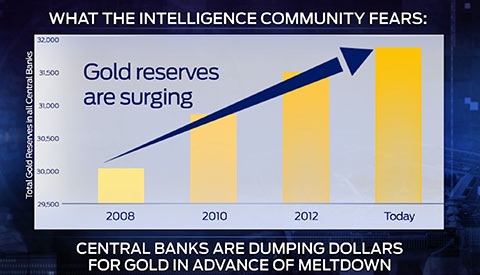
And countries are actually doing that.
So this is basically a global rebalancing of gold reserves.
This is one of the things that the Intelligence Community is watching most closely.
And China is our number one case.
Here’s why: China has acquired more than 3,000 tons in the past four years.
Now they lie about this.
They officially say they have 1,054 tons.
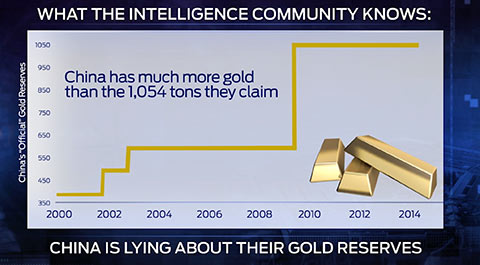
The reason is, China is using their own military and their own intelligence assets to acquire some of this gold in stealth.
I recently ran into a senior officer of one of the major secure logistics firms in the world.
Secure logistics that means these are people who operate vaults and armored cars.
So they handle the physical metal.
They’re not central banks.
They’re not government agencies.
These are Brinks and G4S and ViaMat.
These are the big players in this field.
One of these officials said he recently brought gold into China at the head of an armored column of the People’s Liberation Army.
In other words, he was in an armored car and they had Armored personnel vehicles bringing gold into China.
I guarantee that did not show up in the official Hong Kong import figures.
Now, why is China doing this?
A lot of people speculate that they want to launch their own gold-backed reserve currency, to take the Chinese yuan, back it with gold, make it a global reserve currency.
That’s extremely unlikely.
That’s not what China is doing.
What they are trying to do is hedge against the collapse of the dollar.
China can’t prevent that from happening.
What they can do is build up the gold reserves.
This is known to the Intelligence Community.
This is NOT publicly revealed.
What if it were publicly revealed?
Here’s what global gold reserves would look like if the amount that China owns were actually suddenly revealed.
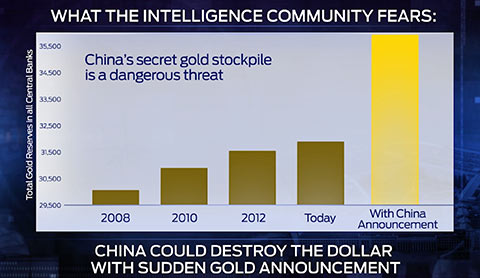
This is a dagger aimed at the heart of the dollar.
Editor’s Note: Jim Rickards’ book, The Death of Money, will help you prepare for the frightening American economic collapse many in the U.S. Intelligence Community fear is at our doorstep.
STEVE MEYERS:
Jim, so far all of these flashpoints have involved China.
Isn’t this an economic suicide mission to attack America?
JIM RICKARDS:
There’s something else here, another flashpoint that could meltdown the global financial system.
What if the U.S. doesn’t bring the entire pyramid crashing down, what if it’s China?
Well, it could very well be.
They have a highly leveraged banking system.
But the banking system is just the beginning.
There’s also something called a shadow banking system.
This is now a $7.5 trillion industry and it’s up 4,067% since 2005.
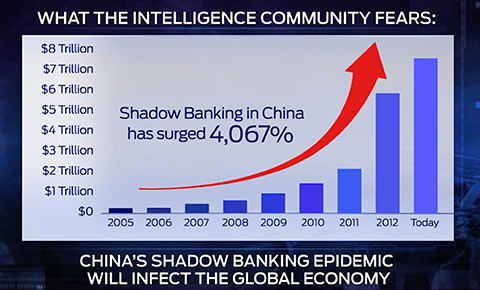
STEVE MEYERS:
This term shadow banking, it’s starting to get play in the press.
How would you explain it?
JIM RICKARDS:
If you put your money in the bank in China, they – it’s just like the United States.
They pay you nothing, zero maybe, one quarter of one percent, something pathetically small.
But, they’re offering these wealth management products that pay five, six, seven percent.
Well, what are they?
Well, they’re actually – they take the money and they buy mortgages on worthless assets, inflated assets and bubble assets that are going to crash.
Before the crash in the United States, before 2008, new construction, as a percentage of GDP growth, that was about 16%.
16% is a pretty big slice.
But, look at China.
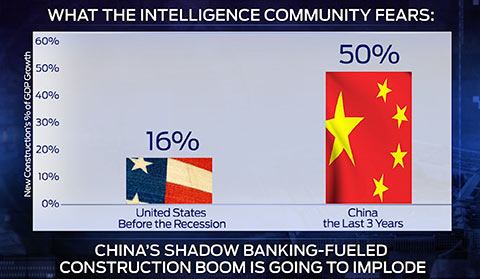
In each of the last three years, construction has been 50% of GDP growth.
They’re building white elephants, they’re building trophy projects, they’re building ghost cities.
I’ve been to China – I was with the Communist Party officials and provincial officials, they were trying to get me to bring some businesses there.
I went to one place near Nanjing.
They weren’t building seven buildings, they were building seven cities.
Every city had a whole cluster of skyscrapers, luxury hotels, athletic facilities, housing facilities, high-end shopping, metro stops, highway access…
And an airport to service all seven of these cities.
This construction was going on as far as the eye can see.
It was all empty.
All of it.
Now, here’s the point.
In the U.S. before the crash, it took about 4.3 years of income to buy the typical house .
In China, it takes 18 years of income.
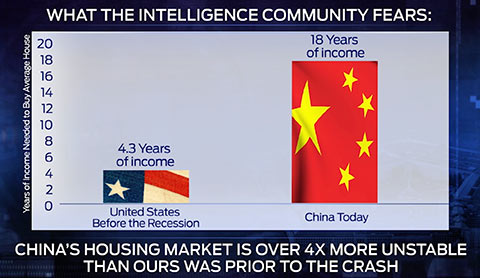
If they’re building apartments, co-ops and condos, and people can’t afford them, you know their prices are going to collapse.
One of the senior banking officials in China said, “This is a Ponzi scheme.”
Those are his words, not my words.
I happen to agree.

But, we all know what happens to Ponzi schemes, eventually you run out of suckers and they collapse.
Once you have enough collapses, there’s going to be a run on the banks.
The bankers are going to say sorry, we can’t pay you, it’s not our problem.
Well, that’s not going to be good enough.
Riots are going to break out.
What does it mean when the world’s second largest economy hits the brakes?
That’s going to be disastrous to global growth; it’s going to pull the rug out from under the sky-high valuations we’re seeing in the U.S. stock market.
This is a set-up for an entire collapse of the global economy.
STEVE MEYERS:
Jim, there’s one more flashpoint I’d like to talk about.
It has to do with a premeditated plan you believe exists inside the IMF, and it involves high-ranking U.S. officials…
To replace the dollar as the world’s reserve currency.
JIM RICKARDS:
It’s not just my belief.
This is actually documented.
It’s a ten-year plan to replace the dollar as the global reserve currency.
The IMF released a report this year, it was called – and get this title – “The Dollar Reigns Supreme By Default.”
And here’s a direct quote…
“The aggressive use of unconventional monetary policies by the Federal Reserve, the U.S. central bank, has increased the supply of dollars and created rifts in the financial system. The dollar status should be in peril.”
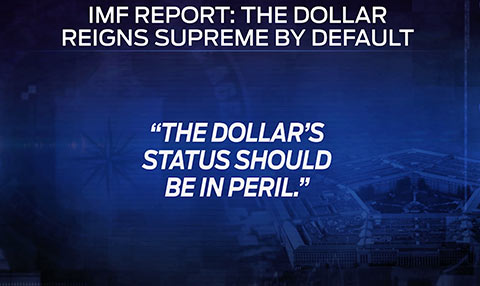
Reserves are nothing more than a savings account for a country.
That’s the amount of money they’ve saved.
But, the problem is, when you have it you have to decide what to do with it.
You can’t just stick it under a mattress, so to speak.
A lot of people think that the dollar will prevail because there are no good alternatives.
That’s not true.
The dollar is declining sharply, as a percentage of total global currency reserves.
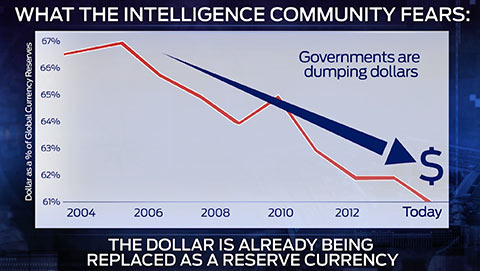
Imagine if that continued.
The euro comes up.
Swiss franc comes up.
Some of the other currencies come up.
That’s one outcome.
But, there’s another outcome, that’s probably coming a lot sooner.
We have a financial panic in the world.
If a central bank has to re-liquefy the world, where is that money going to come from?
It can’t come from the Fed, they’re leveraged 77-to-1.
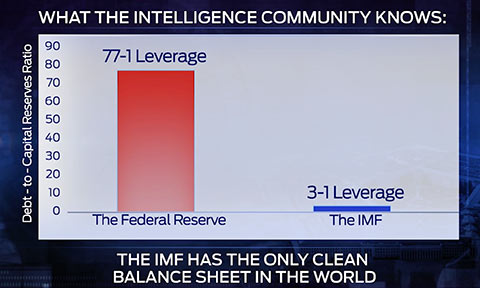
There’s only one clean balance sheet left in the world… the IMF’s.
The IMF, believe it or not, is only leveraged 3-to-1.
When the next crisis comes, it’s going to be bigger than the Fed.
The only source of liquidity in the world is going to be the IMF.
Think of it this way.
The Federal Reserve has a printing press, they can print dollars.
The European central bank has a printing press, they can print euros.
The IMF, the International Monetary Fund, has a printing press too.
They can print something called the Special Drawing Right, or the SDR for short.
These SDRs can come along as a new reserve currency.
The reason they came up with the name Special Drawing Right is because if they called it “world money” that would sound a little spooky and scary.
But that’s exactly what it is.
Here’s the point.
This may be a ten-year plan.
We’re not going to make it ten years.
This collapse will happen a lot sooner than that.
So they’re going to have to dust off this playbook and run out these SDRs and print trillions of them to prop up the system.
Now, if the Fed bailed out private credit in 2008…
And the IMF now bails out the Fed in the next financial panic…
Who runs the IMF? Who’s really in charge?
Well, it’s a nice crowd.
We’ve got kings, dictators, communists…
They’re unelected, unaccountable.
And this is the next flashpoint, really, the IMF taking over the world monetary system and becoming the central bank of the world…
Printing “world money” called the SDR.
STEVE MEYERS:
Jim, these flashpoints…
The attacks on our treasury market and petrodollar…
China’s stealth gold run…
China’s inevitable collapse…
Even this alarming inside job to take down our dollar that’s escalating at the IMF…
You’ve only scratched the surface of what you reveal in your book.
However, the most important message I took away from The Death Of Money is:
Regardless of which flashpoint unleashes the 25-year Great Depression, folks need to understand it’s coming, and coming quick.
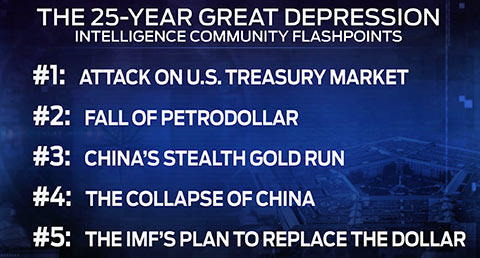
JIM RICKARDS:
Steve, that’s exactly right.
There is a mission in this book and it’s urgent and it’s important.
We’re talking about:
A prolonged depression…
- Massive deflation
- Massive unemployment
- Rampant bank collapses
- A 70% best case scenario stock market drop
This could all start within the next six months.
Look at it this way.
Americans right now are standing at the very bottom of a tall mountain… Mt. Everest, Mt. Kilimanjaro.
About halfway up the mountain, there’s a catastrophic avalanche barreling down towards us.
Determining the one snowflake…
The one flashpoint that’s going to speed this chaos up shouldn’t be our focus.
Recognizing the severity of the situation and moving to safety should be.
So, mission one is helping people hold on to what they’ve got.
That’s going to be more than half the battle ahead.
Continue reading investment tips and adds from source – link





